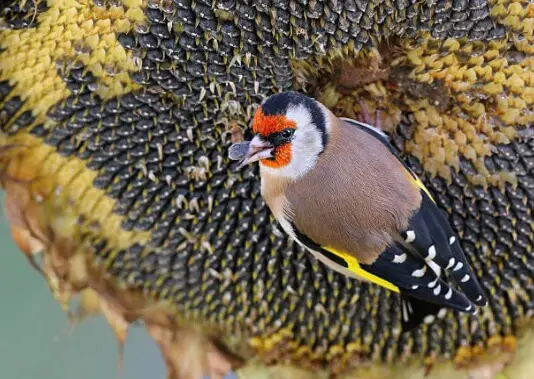Sunflower seeds are a favourite go-to of mine to top up feeders. They’re small enough to fit in most holders and seem to attract a wide range of birds.
Sometimes, when there is a feeding frenzy, it is difficult to see which birds eat what foods. I like to know which species favour certain types of food, that way, I can fill the feeders to attract or help out different birds at different times of the year.
I imagine you can take a guess at which birds eat sunflower seeds…
It is easier to compile a list of which birds don’t eat sunflower seeds; they are popular amongst most of the small songbirds that regularly feed in our gardens.
Finches, tits, blackbirds, jays, nuthatches, starlings, sparrows, and robins are just some of the birds that enjoy sunflower seeds. What is interesting is the type of seed they choose and where they retrieve it from.

Table of Contents
Types of sunflower seeds
All sunflower seeds derive from the common sunflower plant – Helianthus annuus. There are 3-primary types that we serve to the birds;
- Black oil sunflower seeds.
They are the most common type and the ones to attract most birds to the feeders. As their name suggests, they are small, plain black seeds that are rich in oil. They are inexpensive, and their high-fat content makes them ideal for cold months.
Their shells are thin, enabling soft billed birds such as blackbirds to crack them and reach the spoils inside.
They fit in most tube, hopper, or platform feeders; we recommend you place a seed catcher beneath as discarded husks not only create a mess but might also kill lawn or plants.
Finches and tits are most likely to clean you out of black sunflower seeds. The greenfinch, chaffinch, and bullfinch prefer to eat from a flat surface; most tits, especially the blue tit, are acrobats and happily dangle upside from hanging feeders.
Blackbirds and robins have soft beaks but can manage to crack open black sunflower seeds. They are both ground feeders and appreciate it when we sprinkle a few on the lawn.
Only leave enough for them to eat in one session; left overnight, they might attract rats and are toxic to hedgehogs.
- Striped sunflower seeds
These are usually more expensive as they’re fit for human consumption. Striped seeds have harder shells, making them a no-go for the soft billed birds who struggle to remove husks.
They’re not as rich in oil as black seeds, but they are still a valuable nutrition source. Again, they create a mess beneath the feeder that attracts rodents.
Starlings, sparrows, nuthatches, finches, and tits are just some of the birds that enjoy striped sunflower seeds. Some of the larger, ‘bully’ birds such as jays and crows also partake if there is little else available.
We recommend using a caged feeder to discourage the big birds (and squirrels) and let the songbirds eat sunflowers in peace.
- Sunflower hearts
By far the most popular and safest way to feed sunflower seeds to the birds is to fill the feeders with small, white hearts. They are the treasure inside the husk that the birds strive for.
They are most expensive as we are paying for someone to painstakingly remove all the husks – a small price to pay considering they are the tidier alternative.
Sometimes, a bird exerts more energy getting the heart from the seed than it gets from eating it. Sunflower hearts are efficient and easy for them to eat; they conserve energy.
Almost all of our feathered friends eat sunflower hearts; there is no time-wasting; they can get more energy onboard, faster.
Goldfinches are especially fond of them; other birds have a long wait to take their turn at the perch.
Members of the tit family prefer to grab a heart and take it to a safe place to devour.
Robins look for stray sunflower hearts on the ground and swallow them whole.
Wrens are often seen foraging in grass and plants beneath feeders hoping to find bits of sunflower heart.
During late spring as young birds fledge, I like to offer sunflower hearts chopped into small pieces. Occasionally, adults feed these to their young when they know their immature gullets can handle seeds.
Why are sunflower seeds good for birds?
Sunflower seeds consist of most of the food groups and thus, provide a tasty, and highly nutritious snack for the birds.
A 100gram serving typically contains-
- 51% fat in the form of oil
- 21% protein
- 20% carbohydrates
- 5% water
They also contain fibre, vitamins B and E, magnesium, manganese, phosphorous, iron, and zinc.
All of the oils are ‘healthy’ fats; not only do they prepare the birds for the drop in temperature, but the oils also keep their feathers glossy and insulated.
Final thoughts
Most birds eat sunflowers seeds; virtually all of them eat sunflower hearts. Sometimes the husks are too awkward or hard for soft beaked birds to bother with; sunflower hearts are the answer. They are easy to eat, delicious, and nutritious.
If your garden visitors don’t bother with sunflower seeds it could be due to your location or the species that visit.
It might also be due to the variety of foods you offer; your birds might just prefer mealworms, suet, or nyjer seeds.
One final thought, growing sunflowers from seeds is an inexpensive way of feeding our feathered friends and adding a splash of colour to the garden.

Really enjoyed reading this. I make butter balls with much of the Sunday roast left-over veg (unsalted) & push them between tree branches in the hope that the smaller birds get a chance through the winter months.